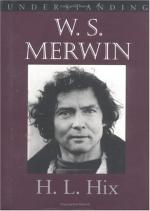|
This section contains 8,825 words (approx. 30 pages at 300 words per page) |

|
SOURCE: Libby, Anthony. “W. S. Merwin and the Nothing That Is.” Contemporary Literature 16, no. 1 (winter 1975): 19-40.
In the following essay, Libby explores the development of Merwin's poetry, noting his increased focus on themes of emptiness and cultural death.
Of the immortal in “Blue” Merwin writes, “There is no pity in him. Where would he have learned it?”1 Colder than any of his contemporaries, the poet himself seems to aspire to such supernatural neutrality. Even more than the glacial Wallace Stevens he has actually achieved what Stevens called “a mind of winter,”2 not simply in order to behold Nothing, but to describe human emptiness with the chill accuracy it deserves. And in a time of apocalyptic poetry no one else confronts the End with such inhuman calm, such studious avoidance of fear or exultation. Even when Merwin seems to welcome the apocalypse he does so in a minor key...
|
This section contains 8,825 words (approx. 30 pages at 300 words per page) |

|


